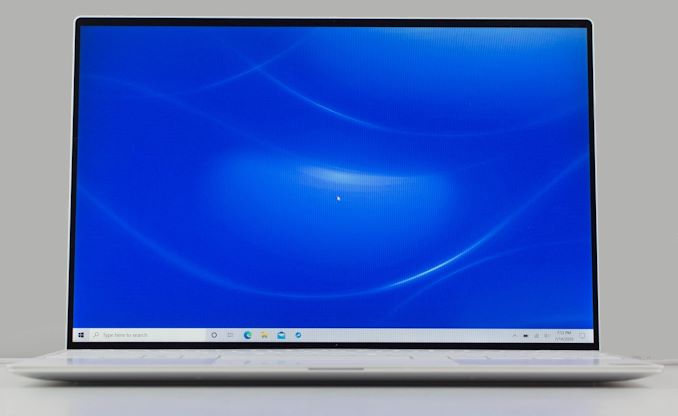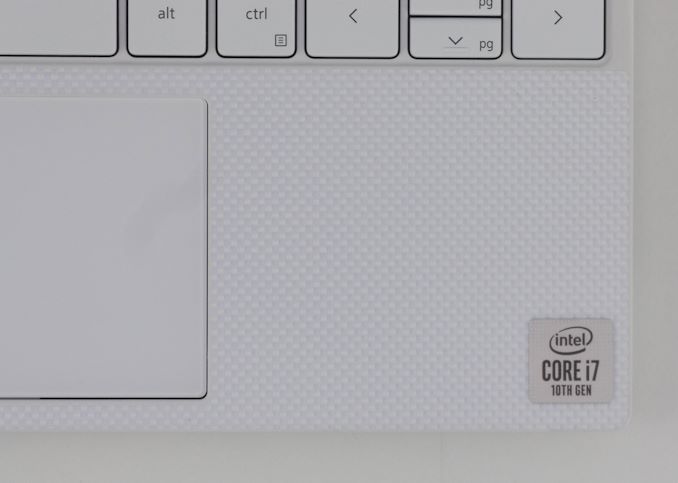The Dell XPS 13 (9300) Review: Return of the King
by Brett Howse on July 16, 2020 10:00 AM EST
Dell changed the Windows laptop market in a single stroke with the launch of the updated XPS 13 back in 2015, ushering in the world of the InfinityEdge display, and moving the entire industry forward. We were fortunate enough to get a chance to check out the precursor to the new XPS 13 back in November, with a review of the XPS 13 2-in-1. Dell had chosen not to rest on their laurels, and the 2-in-1 proved to be one of the best notebooks around if you needed a compact and powerful convertible laptop. Today we are evaluating the traditional clamshell version of the XPS 13, and while it offers many of the same features and design touches, it does so in a more familiar form factor that many customers are going to prefer.
For the 2020 refresh, Dell has made the refreshing move to taller displays, as we saw with the XPS 13 2-in-1. As a result the XPS 13 uses 13.4-inch display panel with a 16:10 aspect ratio, offering more vertical space for getting work done, and some convenient padding to place controls when watching 16:9 content. The larger display fits into a chassis that is actually 2% smaller than the outgoing design, with the new XPS 13 offering a 91.5% screen to body ratio.
This is actually the second time that Dell has refreshed the XPS 13 within the last year. The company previously updated the XPS 13 in August 2019 to use Intel's 10th generation Core processors, but presumably due to limited supply of Intel’s then-new Ice Lake platform, Dell opted to launch that iteration with Comet Lake-U processors. And under more normal circumstances we would have expected Dell to stick with an annual cadence – and thus Comet Lake – for an entire year. Instead, to some surprise, Dell gave the XPS 13 a further mid-generation refresh, launching the Ice Lake-based XPS 13 9300 model that we are reviewing today, and bringing the clamshell XPS 13 to parity with the 2-in-1 version.
The switch from Comet Lake to Ice Lake, in turn, is a significant one. it means the XPS 13 gets Intel’s new Sunny Cove CPU architecture, as well as the much-improved Gen 11 graphics. Dell offers Core i3, i5, and i7 models, with the Core i3 and i5 offering G1 graphics, meaning 32 Execution Units (EUs), and the top-tier Core i7-1065G7 featuring the full 64 EUs on the GPU side. Just as a comparison, the Comet Lake-U only offered 24 EUs of Gen 9.5 graphics, so even the base Ice Lake models still offer a 33% larger (and much newer) GPU than the outgoing models.
The move to Ice Lake also brings some badly-needed LPDDR4X support, which in turn means a 32 GB maximum memory option in the XPS 13 9300, up from 16 GB previously. Although Dell still lists a paltry 4 GB option on their specifications sheet, a quick look at the Dell.com site shows that, at least in the USA, it appears that 8 GB is the new minimum, and that is a welcome change. Offering just 4 GB of RAM in a premium Ultrabook was always a poor choice, even if it did allow Dell to hit a slightly lower price bracket. On the storage front there is more good news, with 256 GB the new minimum, with up to 2 TB available, and all drives are PCIe x4 NVMe offerings.
| Specifications of the Dell XPS 13 9300-Series | |||
| General Specifications As Tested: Core i7-1065G7 / 16GB / 512GB / 1920x1200 |
|||
| LCD | Diagonal | 13.4-inch | |
| Resolution | 1920×1200 | 3840×2400 | |
| Brightness | 500 cd/m² | 500 cd/m² | |
| Contrast Ratio | 1800:1 | 1500:1 | |
| Color Gamut | 100% sRGB | 100% sRGB 90% P3 |
|
| Features | Dolby Vision | Dolby Vision | |
| Touch Support | with or without touch | Yes | |
| Protective Glass | Corning Gorilla Glass 6 in case of touch-enabled model | ||
| CPU | Intel Core i3 1005G1 (4MB cache, up to 3.4GHz) Intel Quad Core i5 1035G1 (6MB cache, up to 3.6GHz) Intel Quad Core i7 1065G7 (8MB cache, up to 3.9GHz) |
||
| Graphics | Intel UHD Graphics Intel Iris Plus Graphics |
||
| RAM | 4 - 32 GB LPDDR4X-3733 DRAM (soldered/onboard) | ||
| Storage | 256 GB PCIe 3.0 x4 SSD 512 GB PCIe 3.0 x4 SSD 1 TB PCIe 3.0 x4 SSD 2 TB PCIe 3.0 x4 SSD |
||
| Wireless | Killer AX1650 Wi-Fi 6 + Bluetooth 5.0 (based on Intel's silicon) Killer AX500 Wi-Fi 6 + Bluetooth 5.0 (based on Qualcomm's silicon) |
||
| USB | 3.1 | 2 × TB 3/USB Gen 3.1 Gen 2 Type-C | |
| 3.0 | - | ||
| Thunderbolt | 2 × TB 3 (for data, charging, DP displays) | ||
| Cameras | Front | 720p HD webcam | |
| Other I/O | Microphone, 2 stereo speakers, audio jack | ||
| Battery | 52 Wh | 45 W AC Adapter (USB Type-C) | ||
| Dimensions | Width | 295.7 mm | 11.64 inches | |
| Depth | 198.7 mm | 7.82 inches | ||
| Thickness | 14.8 mm | 0.58 inches | ||
| Weight | non-touch 1.2 kilograms | 2.64 pounds touch-enabled 1.27 kilograms | 2.8 pounds |
||
| Launch Price | Starting at $999.99 | ||
Dell has gone all-in on USB-C with the new XPS 13, with one port on each side of the notebook. Both feature Thunderbolt 3 with 4 lanes, as well as power delivery for charging. The lack of a Type-A port may inconvenience some, but Dell does include an adapter in the box to assist. Wireless is the Killer AX1650, which based on the latest Intel AX200 wireless adapter – and with Intel purchasing Killer this partnership seems like it is not going anywhere.
If you read our review of the 2-in-1 version of this laptop, you will undoubtedly notice a lot of similarities. As they are from the same product line, that is not an accident: Dell has now refreshed their entire XPS series of laptops with a similar design philosophy. Let’s take a peek at what is new.











224 Comments
View All Comments
sonny73n - Friday, July 17, 2020 - link
Haha... Dell XPS i7 $1400 gets beat up by Acer 4700U $650. Lovely!Based on some comments here, Intel fanboys are a bunch of sore losers.
Walkeer - Thursday, July 16, 2020 - link
a king...with intel...in 2020 XDikjadoon - Thursday, July 16, 2020 - link
I really hope manufacturers copy Dell's strong improvements here: no silly keyboard gimmicks or bloatware (looking at you, *****ing HP), improve the screen contrast, glare, and ratio (you gotta stare it all day), and nail battery life. With a near 16-hour real-world battery life, it absolutely dissuades ARM transitions purely for efficiency.But, while I love Dell's improvements, a few hard-to-swallow regressions here:
-- no type-A port. That's just frustrating. Are we *really* in a type-C-only world? No. And Dell knows that. Why is a "productivity" device (16:10 panel) handicapped? Did we need it thinner? Where the hell are all the PCH's USB / PCIe bandwidth going? Into the ... charge port? We should have 4X type-C ports these days.
-- soldered SSD. An absolutely groundless regression. Goodbye to a last-chance backup if the motherboard dies. And don't even think about out-of-warranty replacements.
-- toasty, toasty, toasty bottoms. 42 W PL2, even with GORE, is absolutely "crazy", as Anandtech points out. Likewise, Notebookcheck notched a nearly 30C idle bottom panel in a 20C room: the heat just exudes out even at idle. Add in a heavy load and you're at a toasty 46C in the back bottom (https://www.notebookcheck.net/Dell-XPS-13-9300-Cor...
And, it should be noted: Dell still sells the older Comet Lake-U models, so buyer beware which "XPS 13" you click on. The product names are identical and both use "10th gen" CPUs.
TheinsanegamerN - Thursday, July 16, 2020 - link
High heat, lack of useful ports and soldered storage make this a worthless device.sonny73n - Saturday, July 18, 2020 - link
Buyers don’t have to beware. Just use it for a couple weeks then return. I went to dell website to check the price and specs of the model AT reviews. They have everything messy. No filter and no year of release for all the laptops they’re selling. Only “for home” and “for work”. wtf? I can’t buy a “work” laptop just to watch youtube at home? How about a laptop for both home and work?I used to prefer dell products especially monitors but since they became intel’s lap dog to monopolize the market, I put them on my “do not buy” list. Overpriced dells are for idiots.
stanleyipkiss - Thursday, July 16, 2020 - link
It WOULD be a solid laptop (the perfect ultrabook even) -- if they had included at least ONE USB A port.sonny73n - Friday, July 17, 2020 - link
NOT when it costs $1400.Sharma_Ji - Thursday, July 16, 2020 - link
Qualcomm based atheros wireless modules were so good, I don't believe how killer ones are so bad, that intel acquired killer, sad that Qualcomm based modules will no longer will be available.invinciblegod - Thursday, July 16, 2020 - link
I don't know, are Qualcomm's wireless modules that good for Windows? I've had many problems in enterprises where Qualcomm's wifi was always unstable compared to Intel's. Though admittedly, at home I never had a problem.shadowjk - Sunday, July 19, 2020 - link
Qualcomm based Killer WiFi is borderline unusable. If you can get the hardware running on the regular drivers from Qualcomm it gets tolerable.